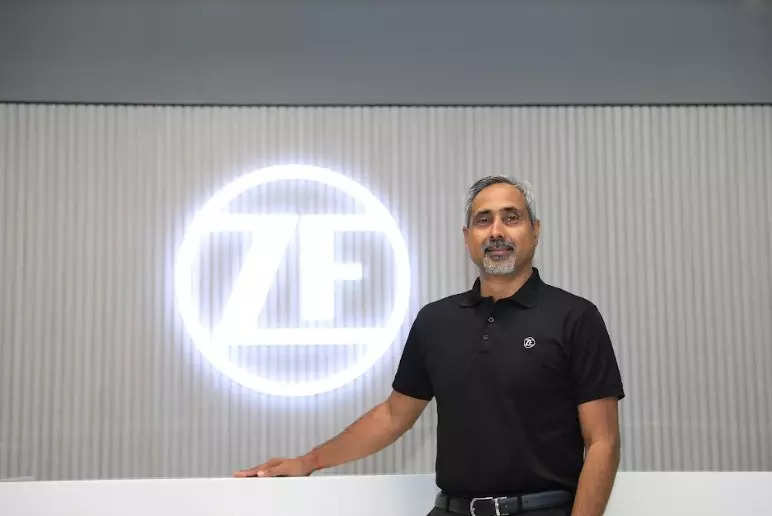
“In my view, 1 plus 1 is not 2 but 11 and that is what we need to do at ZF in India,” says Akash Passey, President, ZF Group – Region India.
According to him, the auto component maker is at a stage now where its ecosystem can be changed to an all-new level. The time has come to begin firing on all cylinders and reach out to customers in a way “where you become the major provider of parts, systems etc with a 80% market share if not 100%”.
It is now a little over nine months since Passey took charge at ZF India after a long stint at Volvo where he held various leadership positions in India and Sweden. The switch from a vehicle manufacturer to a Tier 1 supplier has been “interesting” and the top priority for him now is to ensure that the competencies at ZF India are optimised to the extent possible.
“This is the time for us to buck up and really get into the market. OEM, supplier relations are critical, especially at the Tier 1 level. Only when there is a change in technology does a new Tier 1 sense an opportunity to grow its market share,” says Passey.
He makes no bones about the fact that a lot more can be done now at ZF India and this is an imperative given the huge responsibilities that the German parent company has entrusted to India. Being the era of mobility disruption, it is important for ZF to pull out all the stops and grow its business in India.
Being among the top parts supplier in the world with a strong focus on technology and systems, ZF offers a wide range compared to other players. Has this reflected in its India innings thus far? Passey clearly believes that a lot more can be done going forward.
Bits and pieces
“The challenge we have is that we have a lot of pieces of the cake. Some are very tasty like the commercial vehicle business where we have a 85% share and good customer relationships. Then there are areas where we could do better like passenger cars,” he candidly admits. Beyond this, ZF has a “decent presence” in the construction equipment sector with its axles and transmissions supplied to top brands.
The company has a robust clientele in the passenger car space overseas which is replicated in India with European brands like Volkswagen, Skoda etc but their combined market share here is still minuscule. “We need to take the top three customers in each segment which have a combined 75% share and this means brands such as Maruti, Hyundai and Tata,” he says. While some “key stuff” has been picked up, there is a lot more than can be had with these carmakers and the coming years, therefore, become critical.
ZF India has a turnover of over INR 10,000 crore and it has in its kitty 18 facilities, 10 tech centres and a workforce of 16,000 people along with a “huge bandwidth” of artificial intelligence, digitalisation etc. According to Passey, this is truly a big deal because there are a lot of competencies coming in when it means negotiating business with OEMs.
“It is one India management team with a common vision and we have consolidated our ways of working together,” he adds. Yet, there is a lot more to do especially with all the changes happening across the Indian automotive ecosystem.
Big opportunities
SUVs, for instance, are gaining ground “like never before” compared to small cars and account for over 50% of the market. Being pricier with a host of features means that a Tier 1 player like ZF can capitalise on a lot of opportunities.
Two, continues Passey, safety has become even more relevant in India because of the proliferation of new highways and growing traffic. “Demand for vehicles has changed as a result and specification levels will also change because speeds are higher and more accidents could follow,” he says. With safety regulations now getting stiffer by the day, this again translates into good news for ZF as a supplier of safety solutions.
The “electric revolution” has also kicked off, especially in two and three-wheelers as well as buses with passenger cars and trucks “slightly behind”. Electric parts which are modern and efficient are the need of the hour . They must be cost-effective too and here is where ZF can play a “deeper role” in India.
The internal combustion engine is likely to be around for some years longer in India and that could be an opportunity for ZF since it has plants elsewhere in the world with traditional, yet advanced, technologies like transmissions that can be transferred to India with a longer lifeline. These parts will become irrelevant in an era of electric mobility but can still be used in countries like India where ICE will continue to be part of the landscape.
India’s decade
Passey is absolutely confident that this is India’s decade given the slew of changes that have occurred in recent times. “Incomes have gone up and the middle class is expanding and spending more. At ZF, we need to go flat out since there is a tremendous opportunity ahead,” he says.
Yet, there are some ground rules that need to be followed. Whatever is made in India should be locally sourced. Most of the engineering hours, likewise, should be “taken out of India” given that ZF has a substantial number of engineers on its rolls. Finally, given that validation, prototyping and testing take a long while, the company can do its bit to help out its customers.
“ZF is one of the few Tier 1 suppliers which has a vast test track in India with a number of validation facilities,” says Passey while driving home the point that this is huge strength it has in its armour. It is also his contention that with 18 plants, the time has come to ask if “we need one for each division and not share resources instead”.
ZF also has some good joint ventures where the local partners’ knowledge can be used better. “We have 3,500 engineers in India that do cutting edge work for global OEMs and ZF global engineering. If that strength can be reinforced further for India, it makes a difference,” says Passey.
The underlying message is simple and straightforward: India is a challenging market for sure but it is not enough to be content with just a reasonable share. “When it suits people, they say it is a foreign company but we cannot say that about ZF which has such a humungous presence. What is not Indian about it?” he counters.
Getting proactive
The difference Passey would like to see at ZF India going forward is for the team to ask for more things rather than “ask my parent to think for me”. As he puts it, “I have to be the baby that cries a lot.” By the end of the day, ZF has a strong base in India and is profitable with a positive cash flow and good cash reserves. “Why not put this to good use and start building a greater sense of purpose right now?” asks Passey.
There are three buckets that ZF has conceived as part of its business model: India for India, India for the world and India for ZF. The parts supplier has over 170 plants worldwide of which 18 are in India and over 100 in the US and Europe. “We can do more and more things here to add to the global bottomline to doing things from India for ZF. We have a vision for that and are looking at 300-400% growth out of India,” says the ZF India President.
The company is also targeting “at least” three times growth by 2030 as well as substantially higher local sourcing for the world. The talent pool in India is also expected to play a bigger global role in the coming years given the kind of cutting edge work that is already happening in the engineering centres.

















